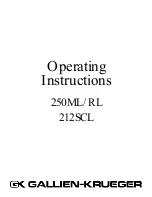
8
Operation Modes
For stereo (dual channel) operation, turn the amplifier off and set the mode select switches on the back panel to the
OUT (extended) position. In this mode, both channels operate independently of each other with their input attenuators
controlling their respective levels. For example, a signal at channel A’s input produces an amplified signal at channel A’s
output, while a signal at channel B’s input produces an amplified signal at channel B’s output.
Stereo Operation
Both amplifier channels can be bridged together to make a very powerful single-channel monaural amplifier. Use
extreme caution when operating in bridged mode; potentially lethal voltage may be present at the output terminals. To
bridge the amplifier, depress the rear panel Bridge Mode switch (17) to the IN position. Direct the signal to channel
A’s input and connect the speakers across pin +1 and pin -1 of the Bridge, twist-lock output connector or the binding
post terminals labeled Bridge.
Bridged Operation
Unlike the Stereo Mode, in which one side of each output is at ground, in the Bridged Mode
both sides are hot. Pin +1 is Channel A’s side, which is the same polarity as the input. The min-
imum nominal load impedance in the Bridge Mode is 4 ohms, which is equivalent to driving
both channels at 2 ohms. Driving bridged loads of less than 4 ohms will activate DDT™ circuitry,
resulting in a loss of power and potential thermal overload.
































